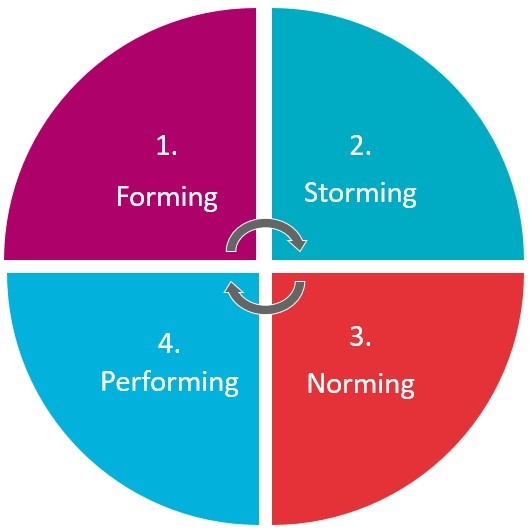It takes time for a team to work to its full potential. Team members will need to get to know each other, their strengths and how they will work together. This theory of stages of team development was developed by psychologist Bruce Tuckman. As a line manager having an understanding of this will help you to determine the management style that you adopt to support your team at different stages.
The theory doesn't only apply to new teams, but can also be relevant when changes happen within teams e.g., when an experienced colleague leaves the team, when a new colleague joins, or when a new line manager is in post. This also highlights the importance of having a quality induction procedure to support new starters in feeling that they belong to your team as quickly as possible, thus helping to reduce anxiety and move on to the next stage.

Stage 1 Forming
Individuals will be generally polite, anxious, but positive about the future – this can be a lengthy process. Individuals will need to know their professional roles and responsibilities as quickly as possible. Processes and procedures will need to be introduced and understood.
At the start, individuals may be unsure of the purpose of the team, their role within it and how they will all work together. People are likely to be anxious or excited to get going, but however they’re feeling they will be looking to their line manager for direction.
This stage will take some time as people get to know their new colleagues, their roles and how they will work together.
Stage 2 - Storming
During the storming stage, conflict may arise as individuals try to push against the boundaries that have been established. At this stage team members may challenge the line manager’s authority or management style; if this isn’t dealt with there could be underlying tensions or confrontations.
If roles and responsibilities aren’t clear individuals may feel overwhelmed by their position or workload or frustrated by their lack of progress.
Stage 3 – Norming
Slowly the team will progress into the norming stage. Any differences within the team will start to be resolved, individuals will appreciate each other’s contributions and respect your authority as their team leader.
Now that team members know each other better they will feel more comfortable asking for support and offering each other mutual advice. They will share a commitment towards your common goal and will make progress together.
Stage 4 – Performing
In the performing stage your team will be reaching their full potential and working together seamlessly to achieve their common goal. Roles within the team may be shared differently as members take on different responsibilities as required. Differences between team members are seen as a strength.
It is worth noting that the cycle can reverse as teams move backwards and forwards between the stages. For example the introduction of a new team member(s) can change the dynamic of the team and may move them back a stage in their development.
Reflective Questions
Find out more here Forming, Storming, Norming, and Performing - Tuckman's Model for Nurturing a Team to High Performance (mindtools.com)

Notifications